Gettysburg National Military Park
Gettysburg in the American state of Pennsylvania is the site of a pivotal confrontation that took place over just three days in the American Civil War. It took place near the small farming community of Gettysburg in July 1863. A nearly 100,000-strong army of Union soldiers led by George Gordon Meade battled against some 75,000 Confederates led by Robert E. Lee. In this short space of time, the fighting left a staggering number of casualties; Meade lost 23,000 of his soldiers and Lee was forced to abandon his invasion of the North and turn back after losing 20,000 under his command. Thousands of other soldiers were left wounded. The retreat from Gettysburg, together with the surrender at Vicksburg in the west at the same time, marked the turning point of the war. However, over a year and a half of heavy fighting would continue until Lee was finally forced to surrender.

More men fell during the battle of Gettysburg than in any other battle that has taken place on American soil. Today, the Gettysburg National Military Park pays a silent tribute to the sacrifice these men made. Many of the Union soldiers who lost their lives here are buried in the Soldier’ National Cemetery where Abraham Lincoln delivered the infamous Gettysburg Address. His speech honoured the men whom gave their lives to help shape America today. Whist there have been many accounts and analyses about the battle here, the most tangible understanding of it comes from the land itself, parts of which still look very much as they did in 1863. Today, the landscape, fences, cannon and even the monuments provide an insight into the understanding of what happened here. A good starting point when coming to see Gettysburg is the Gettysburg National Military Park Museum and Visitor Center and there is more about this further down the webpage.
Above: The fully zoomable map shown here (courtesy of openstreetmap.org) may be of use to the reader with respect to the descriptions of the battle and tour of the battlefield given below on this webpage.
An Outline of The Battle
Following a victory at Chancellorsville, a month later on 3rd June, 1863, Confederate General Robert E. Lee began marching his Army of Northern Virginia westwards from its camps around Fredericksburg, Virginia. After passing through the gaps of the Blue Ridge mountains, the Southerners headed northwards into Maryland and Pennsylvania. The Confederates were followed by the Union Army of the Potomac under Major General Joseph Hooker but Lee, whose cavalry under Major General J.E.B. Stuart was not present during a raid around the Federal troops had no way of knowing where his enemies were. It was by chance that the two armies met on June 30th at Gettysburg, and the subsequent battle which was to take place commenced on 1st July. The battle began when Confederates attacked Union troops on McPherson Ridge, west of the town of Gettysburg. Although they were outnumbered, the Federal forces held their positions until the afternoon, when they were finally overpowered and forced back to Cemetery Hill, south of the town. During the night, the main bulk of the Union army under Major General George G. Meade arrived and took up their positions.
On 2nd July, 1863, the battle lines were drawn up and formed two sweeping arcs. The bulk of both armies were nearly one mile apart on parallel ridges with Union forces on Cemetery Ridge and the Confederate forces on Seminary Ridge to the west. Lee ordered an attack on both Union flanks. Lieutenant General James Longstreet's thrust on the Federal left turned the base of Little Round Top into a mess, the Wheatfield strewn with dead and wounded troops, and overran the Peach Orchard. North of here, Lieutenant General Richard S. Ewell's evening attack on the Federal right at East Cemetery Hill and Culps Hill, though momentarily successful, could not be usefully exploited by the Confederates.
On 3rd July, 1863, Lee's artillery began a two-hour bombardment of the Federal lines on Cemetery Ridge and Cemetery Hill. For a time, this resulted in a mass engagement of firepower from both sides although did little to soften up the defensive position of the Union army. Following this, some 12,000 Confederates advanced across open fields in the direction of the Federal centre, in a failed attack known as "Pickett's Charge". This attack cost Lee over 5,000 soldiers just in the space of one hour and the Battle of Gettysburg came to an end.
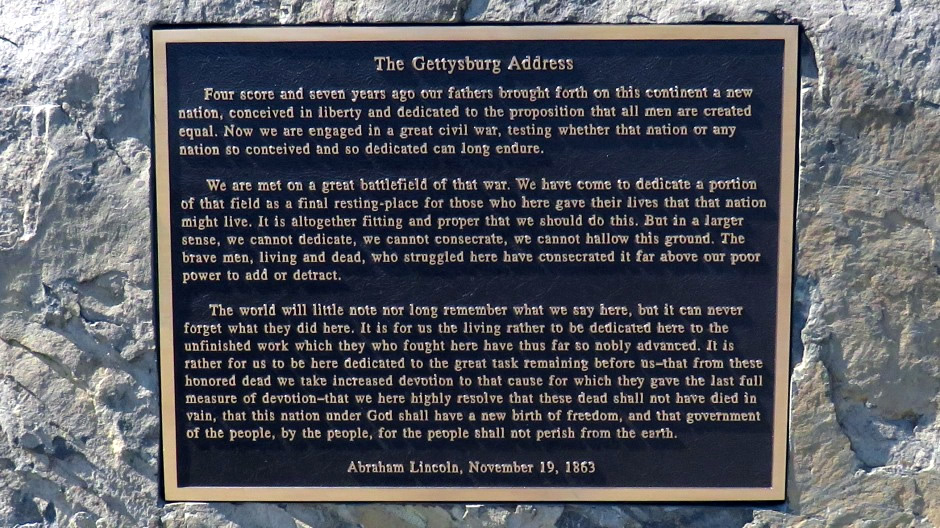
On 19th November, 1863, President Abraham Lincoln took part in the dedication ceremonies for the new Soldiers' National Cemetery in which he delivered his brief, but infamous speech, the Gettysburg Address. His speech gave meaning to the sacrifices of the men who had struggled here, and stated that the war would lead to a "new birth of freedom" for the nation.
A Tour of the Battlefield
It takes the best part of a full day to see the 3,500 acre Gettysburg National Military Park, where the fighting took place in the areas surrounding the town. The photographs below were taken from the 24 mile self-guided tour by car which starts at the visitor centre. It traces the three-day battle in chronological order and at each of the stops along the way are explanatory information boards offering an insight into the events. Across the fields and woodlands of the battlefield site are located several impressive monuments. Further information is available at the visitor centre, where it is also possible to arrange guided bus tours (on this particular visit, some people were even seen taking a tour on Segways).

The photograph above is taken at McPherson Ridge. The battle began at around 8am on 1st July, 1863, to the west beyond the McPherson barn. At the start of the battle, Union cavalry confronted Confederate infantry advancing east along Chambersburg Pike. Heavy fighting spread both north and south along the ridge as backup forces arrived on the scene.

The Eternal Light Peace Memorial is shown above. At 1pm on day one of the battle, Confederate troops under Major General Robert E. Rodes attached from this hill, threatening Union forces on McPherson and Oak ridges. 75 years later, some 1,800 Civil War veterans helped with dedicating this memorial to "Peace Eternal in a Nation United".

The photograph above, of Oak Ridge, was taken from one of two modern-day observation towers which were walked up on this particular tour of the battlefield. Oak Ridge was the site where on day one Union soldiers here held stubbornly against Rodes' advance. By 3:30pm, the entire Union line from here to McPherson Ridge had begun to crumble, eventually falling back to Cemetery Hill. At the end of the first day, the Confederates were in a stronger position. Lee made the decision to continue the offensive, putting up his 70,000-strong army against Meade's Union army of 93,000 men.

Shown above is the North Carolina Memorial. Early on in the second day of the battle (2nd July, 1863), the Confederate army positioned itself on high ground along Seminary Ridge, through town, and north of Cemetery and Culps hills. Union forces occupied these two hills and along Cemetery Ridge, south to the Round Tops. The lines of both armies formed two parallel 'fishhooks'.

A large open field to the east of the Virginia Memorial (above) is the site of the last Confederate assault, known as "Pickett's Charge", which took place on 3rd July.

The photo above is taken near Pitzer Woods. It is here, in the afternoon of 2nd July (day two of the battle) that Lieutenant General James Longstreet placed his Confederate troops along Warfield Ridge, anchoring the left of his line in these woods.
 |
 |
The two photographs above are taken at Warfield Ridge. It is here that Longstreet's assaults began at 4pm. They were aimed at Union troops who were occupying Devils Den, the Wheatfield, and Peach Orchard, and against Meade's undefended left flank at the Round Tops.
 |
 |
|
 |
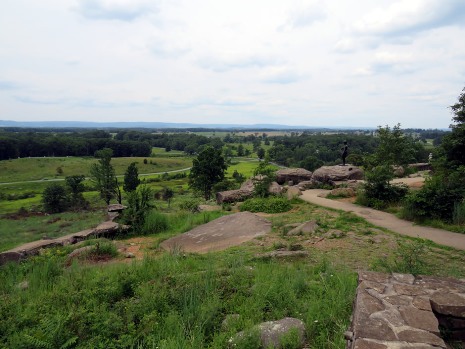 |
|
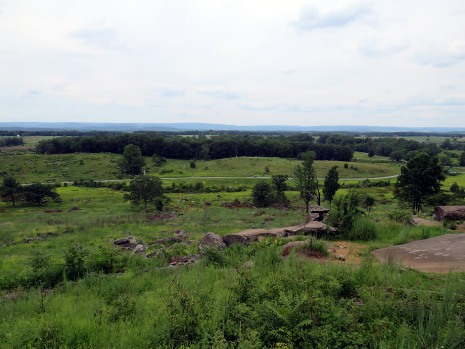 |
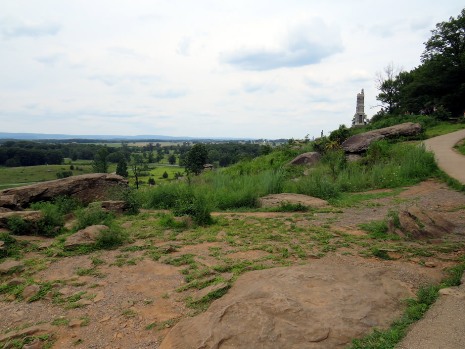 |
The photographs shown above are taken at Little Round Top. Quick action taken by Meade's chief engineer, Brigadier General Gouverneur K. Warren, alerted Union officers to the Confederate threat, and brought Federal reinforcements to defend this strategic position.

The Wheatfield (above) is the site where charge and counter-charge left this part of the battlefield and the nearby woods strewn with over 4,000 dead and wounded troops.

The Union line extended from The Peach Orchard to Devils Den and angled northward on Emmitsburg Road. Confederate forces crossing the Rose Farm towards the Wheatfield came under Federal cannon bombardment until around 6:30pm, when Confederate attacks overran this position.

The next stop on the self-guided tour is at Plum Run. As intense fighting was taking place to the south at the Wheatfield and Little Round Top, retreating Union soldiers crossed this ground on their way from the Peach Orchard to Cemetery Ridge.

The photograph above shows the Pennsylvania Memorial. Union artillery held the line here on Cemetery Ridge late on day two as Meade called for infantry from Culps Hill and other areas to strengthen and hold the centre of the Union position.

The photograph above is of Spanglers Spring. At around 7pm on day two of the battle, Confederates attacked the right flank of the Union army and occupied the lower slopes of Culps Hill. The following morning, on day three, the Confederates were driven off after some seven hours of fighting.

At dusk on day two, Union forces repelled a confederate assault that reached the crest of East Cemetery Hill. By the end of day two, both flanks of the Union army had been attacked and held, in spite of losing ground. Meade, anticipating an assault on the centre of his line, determined that his army would remain fighting.
 |
 |
|
 |
||
The photos above are taken from the High Water Mark stop of the self-guided tour. Late in the afternoon of day 3 (3rd July, 1863), after a two-hour period of heavy gunfire, some 7,000 Union soldiers posted around the Copse of Trees, The Angle and the Brian Farm, repulsed the bulk of the 12,000-man "Pickett's Charge" against the Federal Centre. This was the culminating moment of the battle. The following day, on 4th July, 1863, Lee's Confederate army began retreating. Over the three days of fighting, the total number of casualties killed, wounded, captured or missing was 23,000 for the Union army and as many as 28,000 for the Confederate army.
 |
 |
|
 |
||
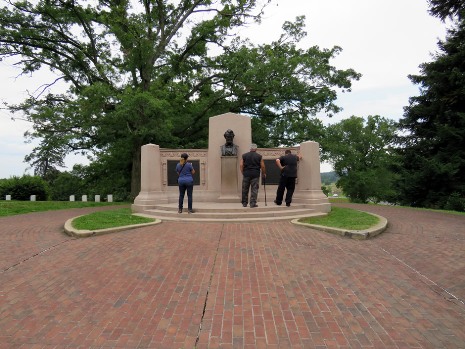 |
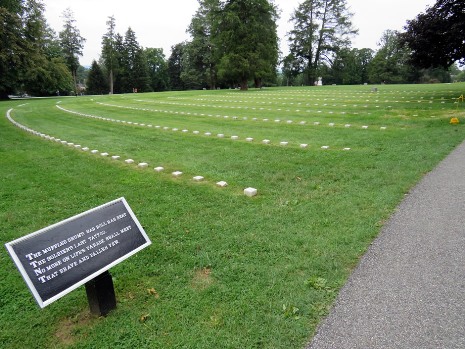 |
|
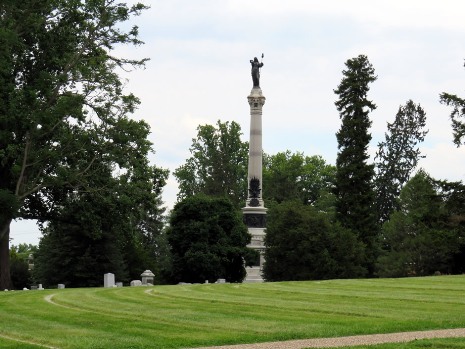 |
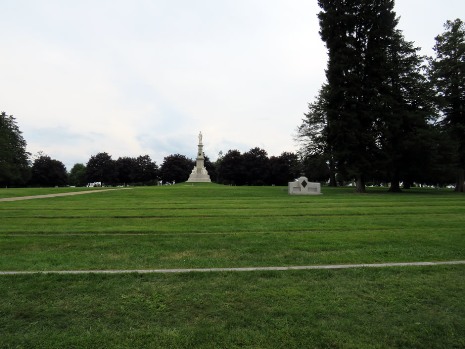 |
The photographs above are taken at the Gettysburg National Cemetery. To commemorate the battle site, a burial ground was purchased on which to place the cemetery. It contains thousands of graves arranged in a semicircle around the Soldiers' National Monument, which stands on the site where Lincoln gave the famous Gettysburg Address, which was delivered at the cemetery's dedication on 19th November, 1863. Hundreds of small marble gravestones can be seen in the cemetery marked only with numbers.
 |
 |
|
 |
||
 |
||
The photographs above are of, and taken from the top of, a modern observation tower. The tower is located on Culps Hill near the eastern side of Gettysburg National Military Park. The bottom photo is a composite image facing northwest, whilst the photo above it is also a composite image, facing southwest from the hill.
Further sites to see nearby include the David Wills House (Wills oversaw the creation of the Soldiers' National Cemetery and it is here that Lincoln finished his Gettysburg Address) and Gettysburg Train Station, both of which may be found in the town.
The Visitor Centre
The visitor centre is located just over a mile south of downtown Gettysburg. This modern and well designed building contains what is considered one of the very best Civil War museums in the state, if not the whole of the country. It contains a huge number of items of memorabilia, including photographs, weaponry, uniforms, surgical and musical instruments, tents, flags and written information. The museum runs through the events in chronological order with repeating videos alongside the displays. Subject matter covered here starts with the early part of the war, the three days of the battle itself and the war's conclusion. Not to be missed here is the stunning moving Cyclorama, a 356-foot 360° highly detailed mural (painted in 1884) of Pickett's Charge, the failed Confederate thrust across open fields in daylight. The charge left over 6,000 Confederate soldiers either dead or wounded. The shop inside the visitor centre may be considered a Mecca for Civil War enthusiasts seeking items of interest including books on this extensively researched part of the nation's history. Photographs taken from inside the visitor's centre museum, including the Cyclorama, can be seen in the thumbnail gallery below (click on any image to expand):
References and Further Reading
Of course, there are volumes and volumes of books and websites dedicated to Gettysburg and the American Civil War, although the following were invaluable in putting the text together for this particular webpage:
1. In-situ literature and information boards
2. Gettysburg National
Military Park Museum and Visitor Center - Official Guidebook
3.
International dictionary of historic places. (1995). Chicago: Fitzroy
Dearborn.
4. Encyclopedia of world history. (1998). New York: Oxford
University Press.
5. Campbell, J. (2008). Lonely Planet USA. Footscray,
Vic.: Lonely Planet.
6. Edwards, N. (n.d.). The rough guide to the USA
[2017].
7. Gettysburg National Military Park on the National Park
Service Website
Here
For any comments or suggested corrections to this webpage, please feel free to contact Robin's Website Here. Disclaimer page Here.

Back to Top